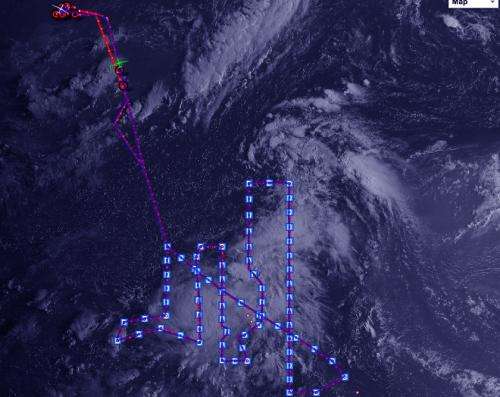NASA's HS3 Mission Global Hawk data used in National Hurricane Center forecast of Gabrielle

Data from the dropsondes that are dispersed from one of NASA's Global Hawk unmanned aircraft assisted forecasters at the National Hurricane Center when analyzing the environment of newborn Tropical Storm Gabrielle at 11 p.m. EDT on Sept. 4.
One of two of NASA's Global Hawks flew over Tropical Depression Seven on Sept. 4, which organized into Tropical Storm Gabrielle.
"During this flight, the National Hurricane Center upgraded the tropical system to Tropical Storm Gabrielle and acknowledged the data that they are getting real time from our aircraft on their website," said Chris Naftel, Global Hawk Project Manager at NASA Dryden Flight Research Center, Edwards, Calif. The Global Hawk deployed a record 80 dropsondes during the mission.
The National Hurricane Center or NHC's second discussion of Tropical Storm Gabrielle on Sept. 4 at 11 p.m. noted that there was a small area of very deep convection near and northeast of the surface center of the depression while the convective bands had largely dissipated over the past few hours. It was at 11 p.m. EDT that the National Hurricane Center classified tropical depression seven as Tropical Storm Gabrielle.
The NHC 11 p.m. EDT Discussion on Sept. 4 noted: Dropsonde data from the NASA global hawk aircraft suggest that the circulation of Gabrielle is tilted to the northeast with height...with a mid-level circulation seen in data from the San Juan wsr-88d Radar. This tilted structure is consistent with southerly to southwesterly vertical shear of 5 to 10 knots shown over the cyclone by the University of Wisconsin Cooperative Institute for Meteorological Satellite Studies and other analyses.
In addition the dropsonde data showed dry air in the mid-levels of the atmosphere around Gabrielle. Given the environment the somewhat disorganized state of the circulation, possible land interaction and the presence of the large area of disturbed weather northeast of Gabrielle, not much strengthening is expected in the short term.
The next two Global Hawk flights are expected to occur over Tropical Storm Gabrielle over the weekend of Sept. 7 and 8. NASA 872 may fly over Gabrielle on Saturday, Sept. 7 and NASA 871 may investigate the tropical storm on Sunday, Sept. 8.
Provided by NASA's Goddard Space Flight Center




















